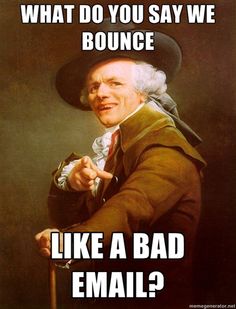
When I was 25, my friends set me up on a date with a girl that sounded perfect. Before meeting her I thought “Wow! This could really be something special.”
Keep in mind, this was before the advent of Facebook (yes, there was a time without social media) so I had to patiently wait.
Unfortunately, I arrived to discover that the girl was nothing at all as she was described. What little knowledge I had of her was enhanced and I was visibly disappointed. If I’d only been able to check out her Facebook beforehand, I’d have known what to expect.
I’m not advocating for stalking in the super creepy sense, but I was brutally reminded that day that there really is only one chance to make a first impression. Whether in your personal life or for business, the opinion you leave on someone can make or break the relationship. In the business sense, you can really take advantage of the tools and networks at your disposal in order to benefit your company.
When it comes to meeting with clients, much can be gained from stalking them beforehand in order to impress them.
Social stalking
Facebook really changed the perception of stalking.
Beyond its helpfulness when preparing for a date, Facebook stalking can also lead you to a wealth of information about your client. From familial relationships and pictures of recent travels to what they share and groups followed, you’ll be amazed at what you can find on Facebook.
Do you have the same interests? Find a way to casually mention it when meeting the client. Have a mutual connection? Use this to your advantage and learn more about the client.
Is a prospective client on other social platforms? Twitter? Lists are a great way to observe people without actually following them. Instagram? Then you know what kind of visually stimulating content they like.
Knowing how someone uses social media gives you the knowledge on how to approach them.
LinkedIn is another great tool for stalking and shouldn’t be written off. Besides, as its own mission statement declares, LinkedIn wants to connect the world’s professionals, so using it to directly contact a potential client isn’t creepy.
Don’t stop digging – a staggering 92 percent of job candidates are found via social media. This means that what your client posts online has potential to be highly relevant to the job that they do.
You never know what you’ll find on their pages that can help you impress them. Even something small, such as casually mentioning an account that the client follows will make them relate to you as a person and will strengthen their loyalty to you.
No email fail
With the help of social media, you can find out a large amount of information from someone solely based on their social media posts.
Duh, right?
Well how about combining social media stalking with your email?
Rapportive shows you, based on the email address, the recipient’s image, LinkedIn profile and groups, Skype name, Twitter handle and more – all from a side panel in your Gmail. You can learn a ton about a client without leaving your inbox.
If you have a client that is always on top of emails, responding at all hours of the night, it’s clear they are very serious about their job and will likely have the same expectations of you. To impress this client, be sure to keep an eye out for and be extra responsive to their emails. When meeting, be sure to be organized and early.
A great tool at your disposal is Yesware as it tracks if and when your email has been opened. You can use this data to gather data on how your client operates – do they return to the email multiple times? Open it right away? Respond immediately or take some time before replying? These are all valuable insights, and it involves very little effort as Yesware takes care of everything for you.
Another trick is to take a look at the client’s email signature – is it fun? Professional? Quirky? Standard?
The way that an email is signed is a direct representation of the personality of the client and the company they work for. A quirky signature might indicate a client would be more open to an “out of the box” approach and that you could get creative in working with him.
When in doubt, Google
There’s a reason that sites like Let Me Google That For You exist.
Not only can you see if the client has any noteworthy accomplishments, you can also see any articles they’ve written or blogs they have. With this, you’ll be better able to judge what’s important to them.
Get blogged
If you’ve found a personal blog or contributions to an online platform, do not underestimate what this can tell you.
What tone does their writing take? From fun and relaxed to to-the-point, you can learn a lot. Is the writing informal or more on the serious side? You should be prepared to adopt a similar approach with the client.
Likewise, the voice can also give you a deeper understanding of how the client operates. A strong and persuasive voice should let you know to prepare for a somewhat bold client who knows what they want. They will not likely ask you for your opinion on the small things and may be overly confident in their ideas.
If you find a personal blog, compare the content – is it at all related to their industry? Is the blog simply a hobby and offers a different goal?
If the blog supplements the business, it shows a certain level of dedication while an unrelated blog shows that he enjoys writing and has a unique perspective to express. Looking into these topics can be relevant in your meetings or a good conversation starter.
Welcome to 2016, where our thoughts are posted publicly, our images shared widely and our personality is available online for casual viewing. In order to make the best first impression possible, it is wise to research.
There are a plethora of outlets to obtain information about a potential client and dazzle them from the first pitch. What comes after that is up to you.
Read next: 5 ways to investigate your competitors like Sherlock Holmes
Get the TNW newsletter
Get the most important tech news in your inbox each week.




